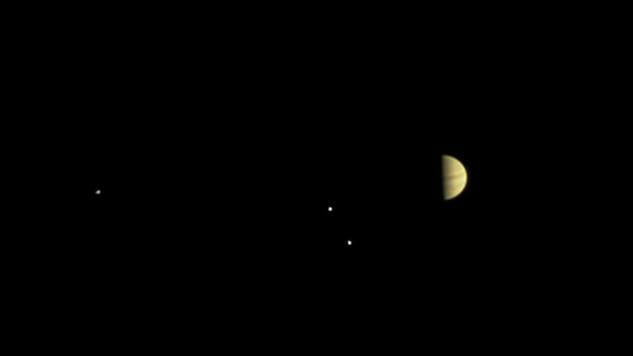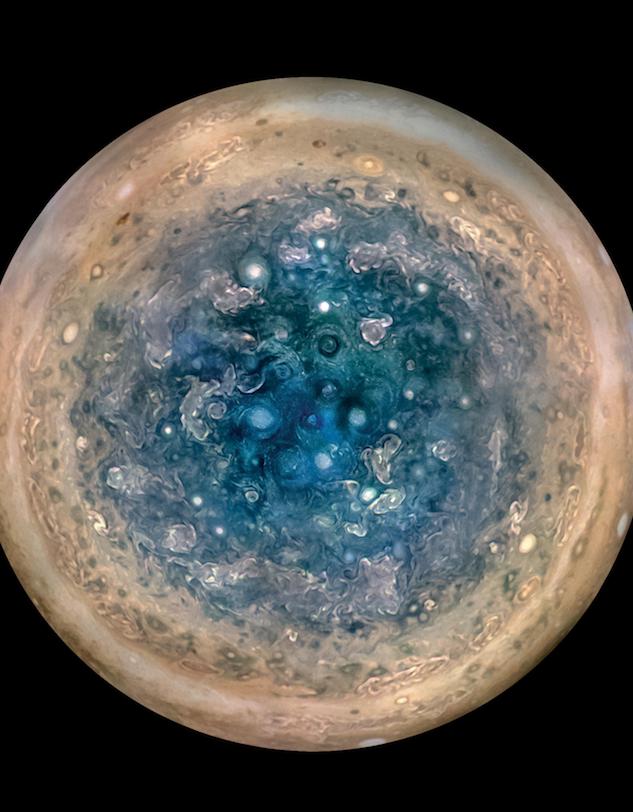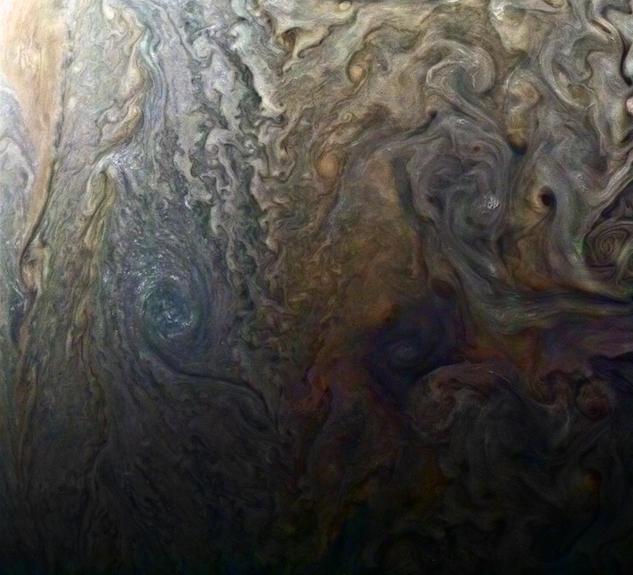
For the last year, the spacecraft Juno has been orbiting Jupiter, the monster of our solar system, snapping pictures and sending back data. The spacecraft was launched in August of 2011 and entered orbit of the gas giant on July 4, 2016. Since then, scientists have been studying the data Juno has been sending back, including vivid and breathtaking images thanks to the high-definition camera on the spacecraft, JunoCam.
Juno’s unique orbit is polar, rather than equatorial, and is highly elongated. This orbit takes it much closer to Jupiter than we have ever been before—as close as 2,600 miles—but it’s incredibly long because of Jupiter’s massive magnetic field, which will disrupt and damage the spacecraft and its delicate instruments. It therefore takes Juno around 53 and a half days to complete one orbit around the planet.
 Jupiter’s bands of clouds. (Image credit: NASA/JPL-Caltech/SwRI/MSSS/Gerald Eichstadt/Sean Doran)
Jupiter’s bands of clouds. (Image credit: NASA/JPL-Caltech/SwRI/MSSS/Gerald Eichstadt/Sean Doran)
That doesn’t mean we haven’t collected some intriguing and excellent data on our largest planet cousin, though. And over the course of this one year, so much of what we thought we knew about the biggest planet in our neighborhood has been turned upside down. And it’s only going to get more exciting: Here are five different things we’ve learned about Jupiter over the past year.
1. Jupiter’s north and south poles are blue.
When you think of Jupiter, you probably picture one of the classic orange and white equatorial photos that is so prevalent. The fact is, until Juno, we’d never actually seen what Jupiter’s poles look like. Jupiter’s tilt is small enough—just 3 degrees (compared to Earth’s 23.5 degrees)—to where the angle is never right to be able to see the poles from our planet.
Juno, however, is in a daring polar orbit of Jupiter and has made some interesting discoveries that will keep planetary scientists occupied for decades. Not only are Jupiter’s poles covered in storms, but they’re stunningly blue. This is both gorgeous and completely unexpected.
 Jupiter’s south pole. (Image credit: NASA/JPL-Caltech/SwRI/MSSS/Betsy Asher Hall/Gervasio Robles)
Jupiter’s south pole. (Image credit: NASA/JPL-Caltech/SwRI/MSSS/Betsy Asher Hall/Gervasio Robles)
2. Jupiter expels electrons as a byproduct of solar wind.
Jupiter has an astoundingly large and strong magnetic field (and Juno has taught us that it’s even more powerful than we thought), and its interaction with solar wind affects the planet’s auroras. On Earth, these charged particles fall into the atmosphere, and that happens on Jupiter as well. But there’s a strange addition to Jupiter’s interaction with solar wind: Electrons actually shoot out of Jupiter’s atmosphere as well. Whether this is a feature of gas giants generally or Jupiter specifically remains to be seen.
3. Jupiter’s core is much larger than we thought.
For a long time, scientists believed that Jupiter had a small, solid, dense core, much like Earth’s iron-nickel core, that was anywhere from 1 to 10 times as massive as our entire planet. Alternative theories suggested that Jupiter had no core at all. But Juno tells a different story from these two extremes: The core appears to be fuzzy, perhaps even partially dissolved. It’s also much larger than previously thought. It’s possible that the core itself is subject to dynamic winds or motions that have affected it over the span of the planet’s life.
 Jupiter’s dark spot. (Image credit: NASA/JPL-Caltech/SwRI/MSSS/Roman Tkachenko)
Jupiter’s dark spot. (Image credit: NASA/JPL-Caltech/SwRI/MSSS/Roman Tkachenko)
4. Jupiter actually divided our solar system when it formed.
This new discovery isn’t actually from Juno, but it’s fascinating nonetheless. A recent study published in Proceedings of the National Academy of Sciences claims that two reservoirs of meteorites and eventual planetary material once existed in our very early solar system. Jupiter is the oldest planet in our solar system (the team’s analysis confirmed this through isotope analysis of meteorites), and thus it was the first to form. Its original core (once solid!) was likely so massive and formed so quickly that it divided these two reservoirs so that they could no longer draw material from one another. This finding supports our direct observations that the inner, rocky planets are so different from the outer gas giants.
5. We have no idea what the Great Red Spot looks like up close.
But we will. Earlier this week, Juno began the closest flyby ever of Jupiter’s Great Red Spot, the iconic storm whose life is measured in centuries rather than hours. What we do know (or, at this point what we think we know—it seems as though everything about Jupiter should come with a caveat at this point) is that it’s the largest storm in our solar system. Winds rage up to 400 miles per hour and it’s about 10,000 miles wide. We’re about to see it up close, and we have no idea what to expect. On July 10, Juno will get as close as 5,600 miles away above the storm’s clouds. You can bet we’re all holding our breath from the pictures of this one.
Top photo by NASA
Swapna Krishna is a freelance writer, editor and giant space/sci-fi geek.